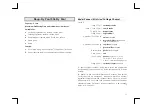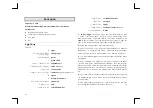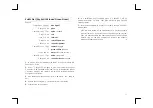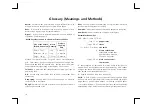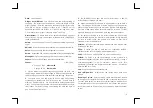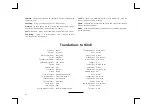
8
Easy Tips for Better Cooking
1.
Read the entire recipe before beginning to work. Assemble and
prepare all ingredients. Follow recipe step-by-step.
2.
Information on weights and measures is on page 9.
3.
Unless otherwise noted, in the recipes:
•
All foods are to be appropriately cleaned and washed.
•
Onions, potatoes, carrots, garlic and fresh ginger are to be
peeled.
4.
For Users Outside India:
In the recipes, size descriptions of
ingredients refer to food available in India. Outside India, follow the
weights rather than the size descriptions.
5.
All Hindi words used in the recipes are translated to English
and/or explained in the
Glossary (Meanings and Methods)
. If you
come across a word you do not know, check
Glossary
pages 18 to 20.
6.
Time and heat settings in the recipes refer to the large burner of
an efficient domestic gas stove unless otherwise specified. You may
have to adjust these times and settings to suit your stove. For best
cooking results, adjust the heat so that cooking times are the same as
those given in the recipes. You will be helped in making these
adjustments by the steps and indications given in the recipes. Avoid
high temperatures for the best cooking results, conserving fuel and
preserving the life of the nonstick coating.
7.
Certain recipes specify "medium-high" heat setting.
By "medium-high" heat we mean a setting between medium and high.
Certain recipes specify "medium-low" heat setting.
By "medium-low" heat we mean a setting between medium and low.
8.
Eggs, batters, doughs and fillings should be at room temperature
before beginning to cook.
9.
To ensure even cooking, cut foods (such as onions and potatoes)
evenly.
10.
Eggs require controlled heat or they may become tough. Eggs
should be cooked on low to medium temperatures. Higher heat
hardens the protein, resulting in rubbery eggs.
11.
Do not heat oil till it smokes. It damages the oil and will burn the
food.
12.
The nonstick coating of the pan retards browning somewhat in
certain foods. For browner results, try cooking slightly longer. Do not
use high heat.
13.
When a recipe calls for boiling, boil lightly not rapidly. Except for
cooking pasta, it is rarely desirable to rapidly boil food. For most
foods, any slight savings in cooking time gained by rapidly boiling the
food is offset by the loss of flavour, texture, nutrients and fuel.

















